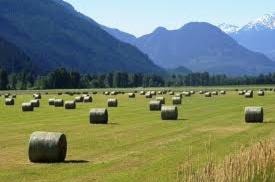How great the feeling is when the sun finally shines. Ranchers and small farmers alike are haying as though the rain may return.
And their hope is that there is enough drying time to get some of it baled.
To say the least, it is nerve wracking waiting for the sun, when the crop is ripe. We know that with each passing day, the nutritional value of the hay goes down.
Simply put, the protein content (necessary for animal growth) goes down, the carbohydrate content goes up with maturity (good for energy in the winter), the sugar part of the carbs drops off making the fattening of the animals slow down.
People who have horses may like the fact that the hay has less sugar content as they don’t want their horses too fat, or worse they don’t want overfeeding which can result in foundering where the fast growth of the hooves can result in injury to the feet.
Ranchers who want their mother cows or growing yearlings to have a high level of protein for growth want the early cut hay or haylage so if the business is big enough to afford it or financially justify it, they have what we call “ silage” or “haylage” equipment.
Such equipment allows a very short drying period—plus or minus a day—before they can wrap it or put it in plastic tubes like sausage. Silos can be used as well and a simple pit in the ground into which chopped or unchopped hay can become the silo.
If the farmer has corn or some other grain crops these pits or rows on the surface can be covered with plastic or sawdust keeping the air out.
The ensiling process utilizes the naturally occurring anaerobic microorganisms for the fermentation.
Read More: ‘Researchers conclude livestock have no detectable effect on climate’
Haylage is usually just the grasses and some legumes like alfalfa or clover, whereas silage technically refers to a grain or corn which is richer feed, often necessary for milking cows in dairies, or growing beef animals.
However, as a general term “silage” in rancher everyday language may refer to any hay crop that is fermented as a preservation technique.
Some crops (Lower Mainland, Peace River, prairie provinces) such as peas or soybeans might have straw left over after the seeds are thrashed out of the plants.
It similar to the straw from grain crops and is often the basic inexpensive cattle feed which make the cattle industry on the prairies a lower cost area to grow cattle.
Here in the Cariboo -Chilcotin, if we have any advantage or strength it is a relative abundance of forage grasses in our pasture and on the range lands.
We have to base our industry on this advantage in order to keep our costs down.
David Zirnhelt is a rancher and member of the Cariboo Cattlemen’s Association.
He is also chair of the Advisory Committee for the Applied Sustainable Ranching Program at TRU.
Do you have a comment about this story? email:
editor@wltribune.com
Like us on Facebook and follow us on Twitter.
